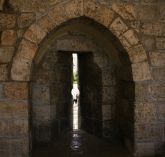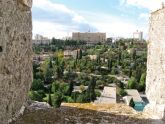×


We have detected your country as:
Please click here to go to the USA website or select another country from the dropdown list.
by: Ilse Posselt, Correspondent, BFP News Room

Photo credit: A Pilcher /BridgesforPeace
If stones could speak, what stories the walls of Jerusalem would tell. They do, after all, play a starring role in many a key biblical and historic event—from humble beginnings, to witnessing the height of a dynasty under Kings David and Solomon. Then came their destruction in the Babylonian rampage, followed by their partial restoration as overseen by Nehemiah and Ezra. Yet disaster struck again. In the aftermath of the Roman siege, Jerusalem’s walls lay devastated, the city ravaged.
More than a millennium passed. Then, some 470 years ago, Sultan Suleiman the Magnificent decided to fortify the city. Using as a foundation the ruins of the walls destroyed in biblical times, Suleiman rebuilt Jerusalem’s ramparts to double as the city’s front lines. On the reinforced walls, watchmen stood guard over the city tucked within.
At first the soldiers stationed there were Turkish. Then British. Finally, Jordanian snipers made it their foxhole. Today, the stone walkways on Jerusalem’s city walls are worn smooth by some 500 years of sandals and boots marching patrols between gates and guard posts, because these walls offered more than a line of defense against attack. The ramparts were also the lookout post, watchtower and vantage point from which to observe life in and around Jerusalem.
Times have changed. While the rampart walls are still frequented by Jerusalem’s security forces, soldiers have not marched along the stone paths for many a decade. And archers no longer hunker behind the bulwarks to rain arrows on advancing enemies. Yet despite the passage of time, the ramparts remain famous for one thing: the best vantage point from which to observe life in and around Jerusalem.

Photo credit: K DeGagne /BridgesforPeace
Today the Ramparts Walk is a promenade around the Old City. One of the Israeli capital’s most prominent attractions, tourists and locals flock to the ancient stone pathways for a journey unlike any other. The 4.2 km (2.6 mi) walk offers a spectacular overview of two worlds: the remnants of the city’s ancient past nestled within the walls, offset by a striking panorama of modern Jerusalem’s skyscrapers and neighborhoods.
The journey around the Old City has two parts. The first starts at Jaffa Gate, a short climb up a winding staircase to where those defending Jerusalem once stood. As you head north, the cobbled stones and narrow walkways wind through the Christian and Muslim Quarters—past churches and steeples, then mosques and minarets. The path leads onwards and over the gates puncturing the city walls—first the New Gate, followed by Damascus and Herod’s Gate. The path finally ends at the Lion’s Gate, where Israeli paratroopers entered during the Six Day War, paving the way for Jews to once again live in the Old City of Jerusalem.
Along the way there are the familiar landmarks of Jerusalem’s municipality building, hotels and high-rises and the grandeur of the Notre Dame de France. Then there is the hubbub of bustling east Jerusalem, the Dome of the Rock and the quiet solitude of the Mount of Olives.

Photo credit: D Williams /BridgesforPeace
The southern part of the Ramparts Walk is shorter. It starts close to David’s Tower and winds south, through the Armenian and Jewish Quarters. The view stretches into Yemen Moshe, Jerusalem’s first “modern neighborhood,” and features the King David Hotel, the famous YMCA spire and the Montefiore Windmill. The path bridges the Zion Gate, from which the Jewish defenders left the Old City during the War of Independence, and finally comes to a halt at the Dung Gate.
A walk around the Old City of Jerusalem has much to offer: spectacular panoramas, history at a glance and a bird’s eye view of the City of Gold. But that is only the beginning. What makes the Ramparts Walk so exceptional is that it provides a window to everyday life as it unfolds in this unique city.

Photo credit: P Fleming /BridgesforPeace
It is a front row seat to the courtyards, cobbled streets, backyards and housewives spreading washing on rooftops. In the late afternoons there are youngsters at play on soccer and basketball fields and grandfathers napping in the shade over dark, syrupy coffee. You will hear the shouts of vendors advertising their wares in the staccato flow of Hebrew or Arabic and smell the spiced earthiness of falafel,. From the alleyways there will be the sound of children laughing, yeshiva students debating and the faithful thronging to the Western Wall before Shabbat wraps around the city.
Because it is here, on Jerusalem’s ancient walls, where you will see, hear and smell the fulfillment of the promise, “Old men and old women shall again sit in the streets of Jerusalem…The streets of the city shall be full of boys and girls playing in its streets” (Zechariah 8:4a,5).
All logos and trademarks in this site are property of their respective owner. All other materials are property of Bridges for Peace. Copyright © 2024.
Website Site Design by J-Town Internet Services Ltd. - Based in Jerusalem and Serving the World.